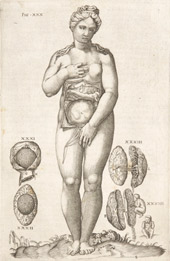 This student-curated exhibit features lavishly illustrated 16th- and 17th-century works from the Sheridan Libraries Special Collections and the Johns Hopkins Institute of the History of Medicine. Seniors Gillian Maguire and Whitney Shaffer served as curators with Elizabeth Rodini, associate director of the Program in Museums and Society and senior lecturer in the History of Art department, as the curatorial advisor. Located on the Main Level of the Eisenhower Library, the exhibit runs from November 5, 2007 to March 3, 2008.
This student-curated exhibit features lavishly illustrated 16th- and 17th-century works from the Sheridan Libraries Special Collections and the Johns Hopkins Institute of the History of Medicine. Seniors Gillian Maguire and Whitney Shaffer served as curators with Elizabeth Rodini, associate director of the Program in Museums and Society and senior lecturer in the History of Art department, as the curatorial advisor. Located on the Main Level of the Eisenhower Library, the exhibit runs from November 5, 2007 to March 3, 2008.
Classical sculpture had a wide-spread influence on the culture of Renaissance and Baroque Europe, influencing artists and scholars alike. Printmakers contributed to the growing knowledge of classicism by reproducing antique works in images that were published and circulated across the continent.
From travel guides to anatomical treatises, this exhibition considers how printmakers and publishers reinvented ancient models to suit different formats and functions. The familiarity of these images attests to the success of the books in establishing a canon of classically inspired figures, forms, and poses.
Renaissance Men expands on the ideas and themes raised in Printed Sculpture/Sculpted Prints, an exhibition at the Baltimore Museum of Art (BMA), also curated by Maguire and Shaffer and their student colleagues, which will be on display from November 14, 2007 to March 30, 2008.
The BMA exhibition results from a collaboration between Johns Hopkins and the museum under the auspices of the Krieger School of Arts & Sciences’ Program in Museums and Society.
During the spring of 2007, Dr. Rodini’s class met weekly in the BMA’s Department of Prints, Drawings, and Photographs. Drawing on the museum’s extensive collection of Renaissance and Baroque prints, the student curators created an exhibition that explores the different reasons that sculpture was represented in print during the early modern period.
The Program in Museums and Society is concerned with the institutions that shape knowledge and understanding through the collection, preservation, interpretation, and/or presentation of objects, artifacts, materials, monuments, and historic sites. The role of such institutions and their contents in societies both past and present, including but not limited to their political, legal, ethical, and economic significance, is central to the program’s concerns. Students interested in learning more about the program and the minor in Museums and Society may contact Dr. Rodini at erodini@jhu.edu.
For more information about Printed Sculpture/Sculpted Prints at the Baltimore Museum of Art, visit http://www.artbma.org/exhibitions/upcoming.html
For more information about the Johns Hopkins Institute of the History of Medicine, visit http://www.hopkinsmedicine.org/histmed
